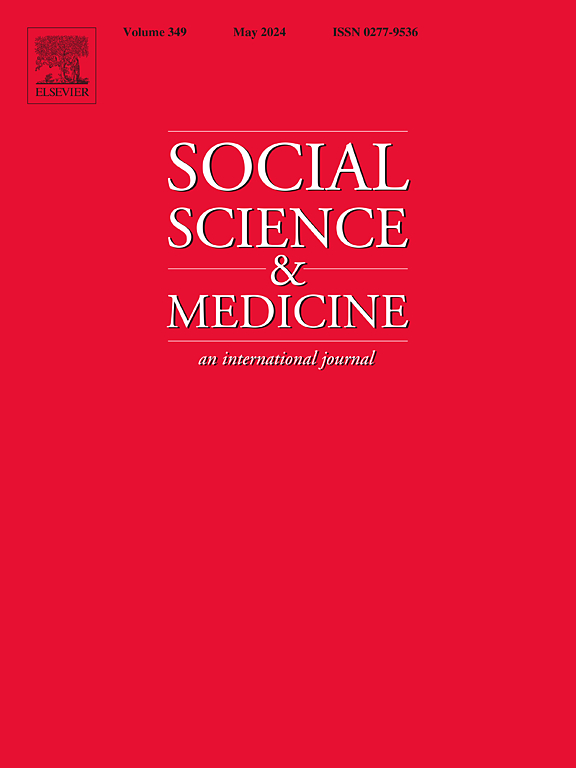移民执法对合法在籍的西班牙裔老年人医疗保健利用的间接影响
IF 5
2区 医学
Q1 PUBLIC, ENVIRONMENTAL & OCCUPATIONAL HEALTH
引用次数: 0
摘要
移民执法可以通过“寒蝉效应”间接影响美国公民和合法移民,即移民由于模棱两可的移民法、公共负担规则和网络效应而完全避开公共资源。间接影响已经记录在公共援助项目的接受率上,但在移民执法如何间接影响寻求医疗保健行为的知识上存在很大差距。我们研究了2008年启动的移民执法项目“安全社区”(Secure Communities)对老年合法西班牙裔移民和公民医疗保健利用的影响。使用来自健康与退休研究(HRS)的有限地理数据,我们采用了交错差异模型,将美国出生的西班牙裔公民和可能授权的西班牙裔移民与非西班牙裔美国出生公民的参考组进行比较。主要结果是与卫生保健提供者进行办公室访问的概率。我们估计,与非西班牙裔美国出生的受访者相比,安全社区导致可能获得授权的西班牙裔移民前往医疗保健提供者就诊的概率下降了16.9%。这些下降不是由健康保险覆盖范围造成的,在健康状况较差和受教育程度较低的个人中,这种下降幅度更大。利用率的下降与寒蝉效应和对他人处于危险中的恐惧有关,因为我们研究中的受访者可能不会立即面临被驱逐出境或其他移民后果的风险。随着移民执法的增加,应进一步努力保护获得保健的机会。本文章由计算机程序翻译,如有差异,请以英文原文为准。
Indirect effects of immigration enforcement on health care utilization among lawfully present older Hispanics
Immigration enforcement can indirectly affect U.S. citizens and lawfully present immigrants though “chilling effects,” where immigrants avoid public resources altogether because of ambiguous immigration law, public charge rules, and network effects. Indirect effects have been documented in take-up rates of public assistance programs, but there is a large gap in knowledge on how immigration enforcement could indirectly affect health care seeking behavior. We examined the impact of Secure Communities, an immigration enforcement program that began in 2008, on health care utilization among older lawfully present Hispanic immigrants and citizens. Using restricted geographic data from the Health and Retirement Study (HRS), we employed a staggered difference–in–differences model comparing U.S.–born Hispanic citizens and likely authorized Hispanic immigrants to a reference group of non–Hispanic, U.S.–born citizens. The main outcome was the probability of having an office visit with a health care provider. We estimate that Secure Communities led to a 16.9 % decline in the probability of having a visit with a health care provider for likely authorized Hispanic immigrants relative to non-Hispanic U.S.-born respondents. These declines are not driven by health insurance coverage, and are even larger among individuals with worse health status and less education. The declines in utilization relate to chilling effects and fear of putting others at risk as the respondents in our study are likely not at immediate risk of deportation or other immigration consequences. As immigration enforcement increases, further efforts should be made to protect access to health care.
求助全文
通过发布文献求助,成功后即可免费获取论文全文。
去求助
来源期刊

Social Science & Medicine
PUBLIC, ENVIRONMENTAL & OCCUPATIONAL HEALTH-
CiteScore
9.10
自引率
5.60%
发文量
762
审稿时长
38 days
期刊介绍:
Social Science & Medicine provides an international and interdisciplinary forum for the dissemination of social science research on health. We publish original research articles (both empirical and theoretical), reviews, position papers and commentaries on health issues, to inform current research, policy and practice in all areas of common interest to social scientists, health practitioners, and policy makers. The journal publishes material relevant to any aspect of health from a wide range of social science disciplines (anthropology, economics, epidemiology, geography, policy, psychology, and sociology), and material relevant to the social sciences from any of the professions concerned with physical and mental health, health care, clinical practice, and health policy and organization. We encourage material which is of general interest to an international readership.
 求助内容:
求助内容: 应助结果提醒方式:
应助结果提醒方式:


